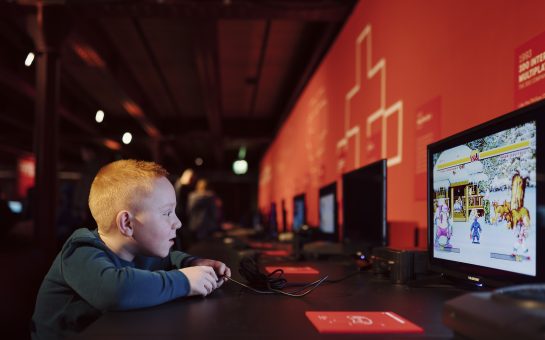Have you ever wondered how gaming has evolved? Read on to learn about all of its changes.
Gaming Today
Games feel like they’ve been around longer than our great-great-grandmas. But have you ever thought about how gaming started?
Since its commercial birth in the 1950s, gaming has rapidly grown. What started off as a technological idea at a science fair has now become one of the most profitable entertainment industries across the globe.
If you are into gaming, it won’t hurt to know some fun facts about gaming and its history.
During the pandemic, but even before then, the mobile technology boom changed the gaming industry forever, introducing a brand-new generation of gamers.
Gaming is so intertwined with popular culture that maybe even your grandma might know what Angry Birds is! Read on to find out why gaming has evolved to the level it has today.
The History of Gaming through the Ages
The Early Years
Let us go back to 1940. The first recognised example of a gaming machine was created by Dr Edward Uhler Condon and seen at the New York World’s Fair.
The game was based on the mathematical game of ‘Nim’ and was played by over 50,000 people in a six-month period.
After this, a game system for use at home didn’t appear until 1967 when Ralph Baer released the “Brown Box.”
The “Brown Box” could be connected to your TV and played by two people. It was programmed with several games, including checkers and ping pong.
This was the first time the world saw advanced gaming technology, with special light features and attachments that took gaming to a new level.
The Evolution of the Game Console
When people think of gaming, they are most likely to think of game consoles. There have been several generations of consoles.
In 1972, Atari (which was founded by Nolan Bushnell, the godfather of gaming) was the first company to set the standard for the gaming community.
Atari began to sell the first real electronic video game, Pong, and arcade machines began emerging in bars, bowling alleys and shopping malls around the world.
These arcade games would soon be brought into many homes and loved by countless families globally.
The next generation of games consoles was the family-friendly, well-known Nintendo. Nintendo released the Nintendo Family Computer.
The technology was amped with Nintendo’s attention to sounds and graphics. Beloved games, such as Super Mario Bros and The Legend of Zelda, were born – games that have lasted the test of time and are still played around the world today.

We move forward to 1987, and Nintendo and Sega progress more in their technologies.
The TurboGrafx-16 was released – a 16-bit system. It was around this time that Nintendo also introduced the first handheld Game Boy.
This went on to have many different versions and became a popular Christmas wish for many children (and adults) across the globe.
It was at this time that Sega created the character of Sonic the Hedgehog to compete with Nintendo’s Mario. (When really, we were blessed with two amazing game characters.)
1993 saw even more progression and gave birth to more games consoles we know and love.
Sony made its debut with the PlayStation and managed to overtake Nintendo’s lead in sales.
Some of the biggest games to emerge were Super Mario Smash Bros, Tony Hawk Pro Skater 2, and on the Game Boy were the popular Pokémon games – Red and Blue. Gaming was consistently evolving in this exciting time.
1998 said goodbye to Sega, as they released their last console, the Sega Dreamcast.
Unfortunately, it made room for bigger and better things; Microsoft introduced the Xbox with Nintendo releasing the GameCube and the PS2 coming out, meaning that the competition was becoming just too fierce for Sega to compete.
Consoles then started to become more suited to families, and the front-runner in this was the Nintendo Wii.
It became the most popular way to bring families together, with interactive games such as Wii Sports, Market Kart Wii and more.
It made playing games more active, which promoted good use for families.

The Move to Your Mobile
Since smartphones hit the scene in 2007, coming with apps in tow, the gaming scene has undergone another rapid evolution.
Introducing gaming to cell phones not only changed the way people played games but brought it to pop culture in a way that had not been seen or done before.
This technology is constantly evolving, meaning that you are never short of a game to play on your phone. Say goodbye to Nokia’s classic ‘Snake’, and say hello to Angry Birds.
This huge shift in the games industry was apparent mostly in Southeast Asia.
This change put gaming at the forefront of all kinds of media attention. It meant that fans from across the world could rally across the internet and social media to swap scores, compare stories and start a new commentary.
Plus, in today’s modern world, influencers and celebrities have started their own games. This has pushed gaming revenue through the roof.
A popular example would lie with Kim Kardashian and her fashion-based game that had rave reviews. Mimicking console games, it became less of what you would expect of a game and more of an interactive story.
What Does the Future Hold?
As you have read, gaming is constantly changing and adapting, and it won’t stop any time soon.
Whether you are a busy millennial with only time for tapping between subway stops or someone immersed in the world of online gaming – there is room for everyone.
The development of VR (virtual reality) technology is starting to show up, which is an exciting time for us all.
It brings opportunities to create fully interactive, dynamic “worlds” where players can feel like they are in real-life situations.
It will make gaming even more social and have the chance to empower gameplay. With such an exciting industry, with a detailed history, you never truly know what will happen next.



